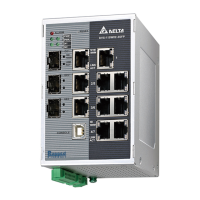Chapter 3 Featured Functions
Trap Flags
Description Factory Default
Authentication
Specify whether authentication traps are enabled.
Enable: Specify the switch which sends authentication trap
messages.
Disable: Specify the switch which does not send authentication trap
messages.
Enable
Cold Start
Specify whether cold-start traps are enabled.
Enable: Specify the switch which sends cold-start trap messages.
Disable: Specify the switch which does not send cold-start trap
messages.
Enable
Warm Start
Specify whether warm-start traps are enabled.
Enable: Specify the switch which sends warm-start trap messages.
Disable: Specify the switch which does not send warm-start trap
messages.
Enable
Link Up/Down
Specify whether link status traps are enabled.
Enable: Specify the switch which sends link status trap messages
when a link comes up or goes down. This is the default setting.
Disable: Specify the switch which does not send link status trap
messages.
Enable
Spanning Tree
Specify whether spanning tree traps are enabled.
Enable: Specify the switch which sends spanning tree trap
messages.
Disable: Specify the switch which does not send spanning tree trap
messages.
Disable
Password Change
Specify whether Password Change traps are enabled.
Enable: Specify the switch which sends Password Change trap
messages.
Disable: Specify the switch which does not send Password Change
messages.
Disable
IP Address Change
Specify whether IP Address Change traps are enabled.
Enable: Specify the switch which sends IP Address Change trap
messages.
Disable: Specify the switch which does not send IP Address
Change messages.
Enable
3.2.2 SNMP V3
SNMPv3 primarily added security and remote configuration enhancements.
Authentication in SNMP Versions 1 and 2 uses a password (community string) sent in clear text
between a manager and an agent. But SNMPv3 message contains security parameters which are
encoded as an octet string. You can choose the authentication protocol which you need to each user
account.
3-35

